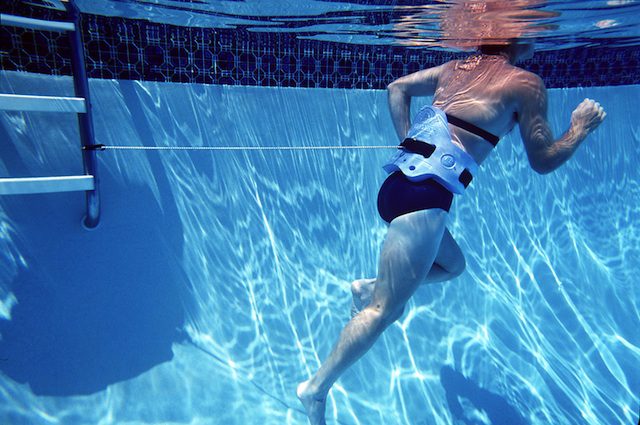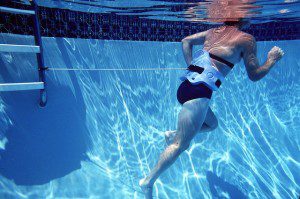Recover and Build Speed with Water Running

Adding some extra run miles to your training week can sometimes lead to breakdown, particularly if you increase your mileage too quickly. One way to increase your run mileage more gently is to increase the frequency of your runs with water runs.
Water runs are performed in deep water (your feet don’t touch the bottom) with a light flotation belt around the waist to help maintain upright posture in the water. Many pools have the belts available but you can buy one at a sports store if your local pool does not provide them. The only other equipment for a water run you may need, other than a swimsuit, is to have is an old pair of shoes. Many people find that water running with shoes on makes the run feel more like an authentic outdoor run.
The structure of your water run workout depends on your goals. You can do an easy run in order to facilitate recovery or, if you are injured, you may use intense water runs to maintain your fitness during a forced break from running outdoors.
For recovery, a thirty minute run in the water is a good way to loosen up and enjoy the benefits of the hydrostatic effects of the water on your muscles. Performing water runs has an almost massage-like effect, which can help stimulate recovery from other training.
If you are injured, most injuries that prevent you from running can be accommodated by the water, where there is no impact. Healing a stress fracture or a turned ankle can be managed with water running. However, an illiotibial band injury in the knee area could be aggravated by the movement in water. Use common sense and a doctor’s advice – you should only do the speed and range of motion that does not elicit pain in the injury.
Some runners may find that pool running doesn’t get pulse rate high enough. Less impact does require more focus on turning the legs over. In water, when you double your speed, your legs encounter a four-fold increase in resistance so there is a lot of strength work being performed but you need to stay focused to keep the heart rate up. Getting a feel for what running in the water is like and getting the technique does take a bit of practice. Eliminating the flotation belt can help maintain a high heart rate if you feel you have good technique to stay afloat without one.
The water can be an ideal environment to do running drills that tend to batter your body on land. The water’s buoyancy permits a greater range of motion. High knees and kicks can be done in the water but care must be taken to not overwork the hip flexors when you first try this work. Some people find benefits in their run stride with water-strengthened psoas muscles in the groin that act as levers during running.
Pool running is ideal for pregnant women, whose shifting centre of gravity is stabilized in the water. The support of running in water eliminates a lot of the discomfort of impact while pregnant. Pregnant women can continue their run training through pregnancy in the water, using perceived exertion and their doctor’s advice as their guide.
Any type of “quality training,” from tempo runs to speed work, can be replicated in the water. For example, you can alternate quick turnover for two minutes with two minutes of easy running. Or you can go hard for 10 minutes, easy for five and repeat. For easy runs, using some up-tempo efforts can help flush lactate from the body on a rest day without delaying full recovery for the next session.
Carolyn Murray – Coach of the NTC Development for Triathlon Canada, offers the following workout for you to try if you decide to take the plunge running.
Workout 1: Frequency Run
10 minute warm up with some drills in the water
Three to four times through:
30 seconds hard effort/30 seconds easy/40 seconds hard effort/20 seconds easy/50 seconds hard effort/10 seconds easy/50 seconds hard effort/ 10 seconds easy/ 40 seconds hard effort/ 20 seconds easy/ 30 seconds hard effort/ 1:30 easy
Easy cool down
Workout 2: Conditioning Workout
Warm up 10 minutes with drills
8 x 2 minutes hard/30 seconds easy
Cool down 5 to 10 minutes
In order to get your heart rate up and help with tracking in the water, Carolyn does recommend wearing shoes and also not wearing the flotation belt for the quality work in the sets. Drills that transfer to the water well are fast feet as you would drill outside, over striding (bounding) feels good to open up the hips, and high knees (again be careful with the range of motion of your hip flexors).

